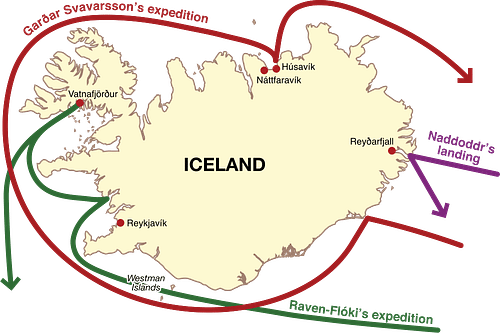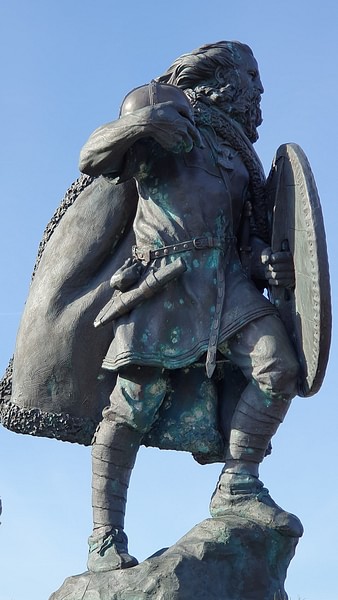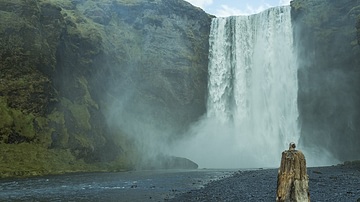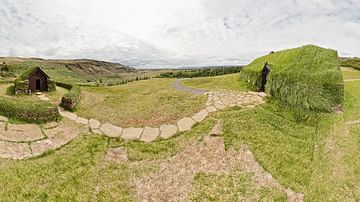
Early medieval Icelandic government, or Viking Iceland, has been termed an incipient form of democracy or democratic parliamentarism, however, the system was actually nothing like its European counterparts, be they medieval or contemporary. Historiography prefers the term 'free state'. As the name suggests, it refers to a freely organized political entity, with some elements of statehood but not quite a state. On the contrary, colonists in Iceland, the heroes of the saga literature, from many points of view created a stateless society. They had a well-defined judicial system and a council of lawmakers (lögrétta), but no king and no one to put judicial decisions into practice. There were differences between chieftains and commoners, but not as big as in many other places. Chieftains had little executive power, and at least in the 10th and 11th century they were not hierarchically organized. Settlers left Norway and other regions to start fresh and arrange their world as nowhere else in Europe.
Chieftains
The colonists (landnámnsmenn in Old Norse) came with political traditions from the continent, and many of them came from the same social class. Iceland gave up the aristocratic layer of continental Viking society and generally the hierarchy of warlords, earls, freemen, and partial freemen. Iceland came to be a society of landowning farmers who were not that enthusiastic about the elites and their roles. Indeed, it might have been what drove them away in the first place. They sought to avoid concentration of power in certain groups and to each have a share of control over the others. Chieftains (góðar in Old Norse) did benefit from some greater authority, but the role was temporary and not territorial. It depended on how many followers they had, if they offered support in disputes, if they could enforce the law, and if they had enough prestige. While in Scandinavia farmers lost rights to the growing authority of kings and other leaders, Icelanders rejected a centralized state. In the words of Jesse Byock, it represents "an example of a self-limiting pattern of state formation" (Viking Age Iceland, 66), meaning that they did not want to evolve but to come back to simpler forms of coexistence.
Local influential men can be seen as leaders but only small-scale ones. Some chieftains but also farmers (bændr in Old Norse) had more wealth and prestige than others, thus being similar to ranked societies. Chieftains could have slaves, tenants or labourers, however, slavery disappeared in the 11th century. Goðar typically competed not only for riches and status but also for followers (thingmenn in Old Norse), who were very important to assert dominance. They arbitrated in disputes, which was risky business that could get you killed, yet perhaps worth the risk, given the economic benefits. They transferred properties, gave loans to farmers, and increased their prestige by offering gifts, a practice that consolidated alliances. They held carefully planned feasts, especially at harvest time, where they displayed their generosity and importance.
It seems that chieftains acquired much less income than we would expect, due to the relatively simple economy and scarce resources. One main source of wealth, besides renting land or cattle, was intervening and settling a dispute. Technically, farmers could also do this, but chieftains were more qualified because they knew more of the law. Nevertheless, social barriers could be overcome, as farmers could become goðar, and rank depended on law and convention. Farmers could switch their loyalties from one chieftain to another, concentration of power was avoided, and authority was a pretty loose concept. This situation would change in the 13th century, once small groups gained more power, stimulated by the medieval Church among other factors.
Stateless Society
Economy was simple, the main unit was the self-sufficient farm, dependant on grazing, hunting and gathering. There were no towns, and conflicts were sometimes solved by feuding. Were Icelanders incapable of founding a state? More likely they had no interest. Norsemen in the 10th century were quite enterprising; they conquered and settled parts of England and established trade routes all the way to the Byzantine Empire. When settlers arrived in Iceland, we must assume they carried with them an important part of the social code of Scandinavian communities. This can be seen in the sophisticated laws dealing with property and ownership, seeds of discontent and competition heavily exploited in medieval literature, the sagas.
Iceland’s society was, on the other hand, different than the tribal ones with warlords and lands, characterized by power established in a certain area. Icelanders gave up part of the Viking culture, that of military prowess, conquests, and kingship, opting for consensus instead. Farmers agreed upon the fact that no chieftain should ever dominate and become an overlord. Their organization was based on social relationships that replaced statehood. Dreamy as it might sound, it was not devoid of serious downfalls. The intricate social arrangements formed by kinship, alliances or friendships could put limits to conflicts but not avoid violence. Sagas relate cases when feuds escalated to the point of no return and turned out deadly.
Law & Order
Iceland was a society of immigrant freemen fighting over scarce resources. They emigrated at a time when the rights of common farmers were threatened by kings who sought to expand their power. As such it is understandable that they detached from the parent society and had no interest in building the same system. In the 9th century, the island seemed attractive because in other parts of Europe rulers like Alfred the Great (r. 871-899) in England were leading campaigns against Viking invaders. In Norway, where most settlers came from, king Harald Fairhair (hárfagri, r. c. 872-933) from the southeast sought to control the entire region and, together with the earls of lade from Trondelag in the north, subjugated farmers and local military leaders called hersar.
Icelandic author Snorri Sturluson writes in the 13th century that King Harald’s tyranny drove people away. While Snorri might have exaggerated, it is part of a national myth: the rejection of hierarchical arrangements and settlement of a primitive parliament called the Althing.
King Haraldr claimed possession of all land wherever he gained power and had each farmer, powerful or not, pay him a tax for the land. He appointed a jarl in each fylki [province] who would give judgments at law and collect the fines and the land tax; the jarl would keep a third of the tax for his food and living expenses. Each jarl would have four or more hersar under him, and each of the latter would have a revenue of twenty marks. Each jarl would provide the king's army with sixty soldiers and each hersir would provide twenty men. (Heimskringla ch. 6, tr. Jesse Byock, 54).
When people first arrived in Iceland, they only found some Irish monks who then left. The earliest took large chunks of land, which caused a dispute with later newcomers. The Landnámabok, or Book of Settlements, tells us that King Harald was asked to intervene and he decided that no one should possess a larger area than he could carry fire over in a day. In succeeding generations, lands came to be divided among many small farms, so no one could claim any real authority. Geography did not encourage a vassal system either, so ties of dependence soon disappeared in favour of private ownership. The lack of external threats also discouraged the formation of defensive networks dominated by lords. However, as the population increased, the need for a common law became quite clear.
Assemblies & Courts
The common assembly, the Althing, was founded. According to historian Ari the Learned in Islendigabók, or The Book of Icelanders, a man named Úlfljótr went in the 920s to Norway to adapt the laws of west Norwegians of the Gula assembly to Icelandic requirements, clarify legal matters, and bring back a legal code. Because of the lack of similarity to Grágás, The Law of the Grey Goose used in the 13th century but likely preserving some older laws, Ari’s story is not very convincing. Either way, a gathering was formed and 39 men became góðar, based on their kinship and local prestige. This term could mean chieftain-priest, and since there was no recognized priesthood, they probably performed official sacrifices. Chieftains needed to hold the local things (assemblies), and by the 10th century, there were probably 13 of these.
All chieftains and their thingmen gathered at the summer assembly, the Althing, on the Thingvöllr (plain) in the southwest. It was then the law council (lögrétta in Old Norse) met, to pass or review laws. The court represented Iceland in foreign affairs as well. Everything was public, with people sitting on benches in three circles. After the conversion to Christianity, a small church was built on the site, other than that people lived in tents or turf booths. There were no officials except for the law speaker (lögsögumaðr), on a three-year term. As the name suggests, his main task was to recite a third of the laws by heart, and despite its prestige, the function did not have any real power attached to it. There was one more resounding position, but again with no authority. The supreme chieftain (allherjargoði) was supposed to hallow the Althing and limit the sections of the assembly. This office belonged to the heirs of Thorsteinn, son of Ingólfr Arnarson, Iceland’s first settler.
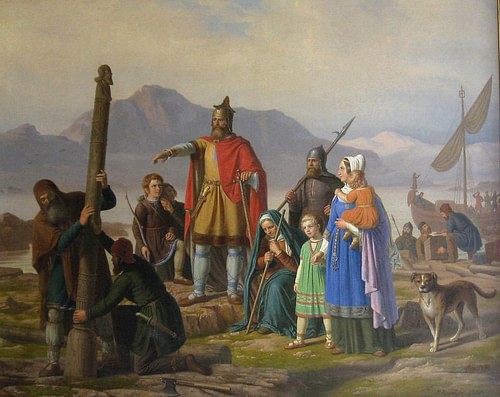
In the 960s, following a deadly conflict, some reforms were introduced. Cases of manslaughter, which was publicly owned up to and different from murder which a concealed and shameful crime, would be brought to the Althing instead of the local gathering. Quarter courts were held, and the island was also divided into four quarters. The western, southern, eastern quarters had three gatherings led by three chieftains each, but the northern one got an extra one due to its geography. The potential imbalance at the Althing was fixed by adding three more goði from each of the other quarters, bringing the total number of chieftains to 48. The new chieftains though had no right to appoint judges. This brought a more centralized legal system, but at the same time, the country remained quite decentralized, based on the relationship between the chieftain and the farmer.
Another reform was the quarter assembly (fjórðungathing) dealing with the affairs of each quarter, although little is known of it and it might have been overshadowed by the Althing courts. The panel of judges selected by lot had to weigh facts and deliver a verdict. The process had rules of procedure and was open to the public. Anyone had access to the courts, however, being successful depended on how able you were to attract support. Settling a dispute required negotiations between the chiefs. In 1005, a fifth court was added (fimtardómr), for when processes came to a deadlock. The last reform of this system was the addition of the two bishops to the lögrétta.
These courts were not only the expression of the accepted social order but also a proper environment for the chieftains to put forward their ambitions. They met with farmers to settle disputes, to negotiate power, to advocate positions, to gather followers. Such actions were crucial because Iceland had no executive power to put the verdict into practice. The intricate structure of the courts with all the procedures also meant other ways to settle. The parties could come to a compromise, and one party could even offer sjálfdæmi, allowing the other party to set the terms of compromise. Single combat, or hólmgange, was not that frequent and ended up being outlawed in the 11th century. Negotiation was more attractive.
The offended could also choose blood feud, a topic sagas like to explore. Seeking vengeance, however, depended on the support of kinsmen and followers and often turned messy and endless and so the parties had to finally go to court. The less formal option of arbitration involved other, more neutral people. Arbitration allowed everyone to withdraw from dangerous situations and to enjoy an acceptable ruling.
Unlike Iceland, Norway had a system that also took into account the functions and roles of kings, military leaders, or clerics. Icelanders in the 10th century developed the old rights of freemen in the Germanic world without all the layers of Norse society. They extended the old idea of local gatherings of commoners and used them instead of the more centralized and pyramidal kingdoms growing on the continent. This is not to say that early Iceland was not ranked, but Icelandic chiefs had way less authority than their Scandinavian counterparts. Until the dominance of overlords in the 13th century, there was no formal barrier to social mobility. However, a chief needed to prove his abilities to keep thingmen around. Friendship had to be paid for; something not always easy to do given the limited wealth of the island.
Feud in Iceland also had its characteristics. Unlike the continent, it was a public matter here. Icelanders kept some of the military values they brought from the continent; they could pose as fierce warriors, but the battles described in the sagas are small-scale and limited to families. Faced with a more peaceful location and yet harsh nature that needed to be tamed, the settlers soon realized the importance of restraint. Small groups might have been at times motivated to kill some opponents, but feuds never reached the level of large-scale open fighting. In the great village of Iceland, there was a lot of honour and prestige to be gained from acting as a mediator or containing troublesome behaviour.
A Story of Law & Feud
In the Saga of the People of Eyri (Eyrbyggja saga), Arnkel goði decides to take a property he had no right to, upsetting other farmers who ally themselves with an enemy of Arnkel. The story takes place in the small region of Snæfellsnes, in the west of Iceland. Bólstaðr, Arnkel’s farm, is too small to support his ambitions. He has got his eyes set on Kársstaðir, the farm at the innermost point of the fjord, with hay meadows and salmon. The sons of Thorbrand, who live here, sense Arnkel's territorial ambition, which is confirmed when he claims properties in the west and cuts their route to Helgafell, a little to the north where their chieftain Snorri lives and the assembly takes place.
Arnkel’s father Thorolf had been a Viking who acquired a lot of land by duelling. Later he sold some of the lands to Ulfar and Orlyg, two slaves freed by Thorbrand. One day, Ulfar confronts Thorolf about stealing some of his hay, but the old Viking plots to kill him by inciting his slaved to set fire to his house. Scared to death, Ulfar places himself into the protection of Arnkel and transfers his property to him in exchange. Thorbrand’s sons are not so thrilled about this since they consider themselves the owners of his farm. The law was vague here, stating that the former owner could become the heir if the former slave could not manage or had no sons. Ulfar has no children but is doing pretty well.

Thorbrand’s sons are not chieftains and so they have little power against the old Viking. Instead of summoning Arnkel directly to the assembly, the brothers ask for the help of the chieftain they are loyal to, Snorri. Arnkel’s father goes to Snorri too, furious about the death of his slaves who tried to kill Ulfar. He did not get any compensation for them and as an act of revenge against his son, Thorolf is willing to bargain with Arnkel’s opponent. Snorri agrees to favour Thorolf in prosecuting his son after he transfers some property with a valuable forest to him. At the court, Snorri states that Arnkel should have killed the slaves when caught burning Ulfar’s house, not afterwards. After arbitration, Arnkel pays a small sum to Snorri, making Thorolf even angrier as he gave up his land for this. Arnkel is also angry because his father transferred his rightful property illegally.
To assert his control over the forest, one day he kills one of Snorri’s men caught taking wood. In the meantime, he also takes over Orlyg’s property, Ulfar’s brother, this time illegally. He is getting closer to the farm of Kársstaðir. The humiliated sons of Thorbrand do not get Snorri’s help this time either, but he worries when accused of not being able to keep his authority if he just stands still. Ulfar is killed by one of Thorolf’s men, with Arnkel gladly claiming his property. He warns Thorbrand’s sons not to challenge him. Snorri reminds his followers that, in the end, the property lies between their farm and Arnkel’s and will fall to the stronger. Arnkel has become way too strong and ended up controlling almost all the fjord, but Thorbrand’s sons have the support of another chieftain and wait for the perfect moment to strike when Arnkel is only with a few slaves to tend to his hay.
The story shows the dangers a leader faced when letting his ambitions run over the top. Farmers could be cheated, but not ignored. Farmers needed to know how to assert their rights. Both compromise and violence were options, but with the right support and at the right time. Such stories point out the low likelihood of chieftains enjoying too much power for too much time.

